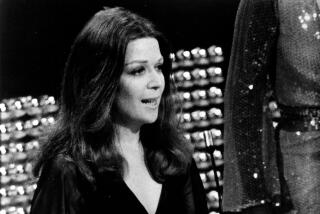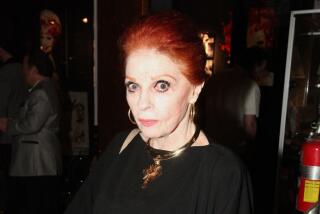Still More Reasons to Love ‘Lucy’
- Share via
Two years before the 1951 debut of their landmark sitcom “I Love Lucy,” Lucille Ball and Desi Arnaz made their first TV appearance together in a live episode of the comedy-variety series “The Ed Wynn Show.” What remains is a scratchy, faded kinescope with a magical Ball and Arnaz, especially in a sketch with Wynn spoofing silent films.
The historical TV moment is one of the many programs featured at the Museum of Television & Radio’s “The Unseen Lucy and Desi: Treasures From the Vault,” which screens through March 5.
The screening series consists of three segments: “The Early Television Years,” “Lucy on the Rise” and “The Later ‘I Love Lucy’ Years.” Included are such fun bits as “The Dedication of CBS Television City,” from 1952, in which Jack Benny keeps popping up on the “I Love Lucy” set; the original animated opening of the series, featuring Ball and Arnaz as stick figures; a 1954 “Toast of the Town” tribute to the series with Ed Sullivan; new openings for repeat episodes of the series; and one of their last appearances together in a 1959 installment of “The Milton Berle Show,” which was directed by Arnaz.
In conjunction, L.A. Theatre Works is presenting Marilu Henner, Jeff Conaway, Harold Gould and Alley Mills in a re-creation of two episodes of Ball’s radio show “My Favorite Husband.”
“We wanted to do something very different,” says curator Ron Simon about the origins of the series. “We have done Lucy over the years. We had Lucy at the museum in the mid-’80s. But we were just looking at various materials. There was a whole story to tell about the Lucy character using material we had not seen that often.”
Some of the material was already part of the museum’s collection, and some was acquired by Gregg Oppenheimer, son of “I Love Lucy” head writer and executive producer Jess Oppenheimer. Gregg Oppenheimer had learned about some unseen footage while researching his book, “Laughs, Luck . . . and Lucy.”
“In the back of the bound volumes of the scripts were these little scenes which didn’t relate to anything else,” says Oppenheimer. “I finally figured out what they were--they were special alternate opening scenes that were shot when they showed reruns.”
Back in 1953, there were no such things are repeats. “There wasn’t any rerun market,” he says, “because before ‘I Love Lucy,’ all the shows were done live.”
But when Ball became pregnant in 1952 with Desi Arnaz Jr., she couldn’t work the entire season. “They had to find some way of padding a season,” Oppenheimer said. “So Dad basically invented the rerun. Because nobody thought anyone would stand for playing the show again, he said, ‘We’ll do new opening scenes.’ So they did that.”
*
One of the most touching sequences from the “Toast of the Town” tribute occurs when Arnaz breaks down crying when he talks about his good fortune, and that when he and his family came to American from Cuba, they had nothing and his first job was cleaning bird cages.
“Desi was very sincere about that,” says Madelyn Davis, who along with her partner, Bob Carroll Jr., wrote every episode of the first four seasons with Oppenheimer. “Lucy got teary and even Ed Sullivan. Desi wasn’t kidding. They had nothing.”
Despite the fact that Ball was an ace comedian, she wasn’t a funny person. All of her slapstick business was written into the script. “She wanted us to do that,” Davis says. “Not that she didn’t add to it on the set, but she wanted the guidelines and then she could have fun with adding here and there and doing physical shtick.”
“The stage directions were in black, all caps, margin to margin, and sometimes it filled the whole page,” says Oppenheimer. “There was so much black on the page,she called it ‘the black stuff.’ ”
Oppenheimer adds that his father considered the cast a little theater group. “They would stay there until midnight in the middle of the week of rehearsals with everybody having their say about what they thought this character was doing. It was very much like an amateur theater group.”
Although Ball and Arnaz were having marital problems during the latter part of the series and co-stars Vivian Vance and William Frawley didn’t get along, it never showed on screen.
“Some of the appeal of the show is that you watch Lucy and Desi, and you can tell they are really in love,” Davis says. “I think people sense that. It was nice.”
*
Even after Ball and Arnaz divorced in 1960, says Davis, there was still a strong bond between the two. “They used to talk on the phone after the divorce. I could always tell when he was talking to her by his tone of voice.”
Davis says everybody thought they would get back together. “The fans didn’t want to hear [about the divorce],” she recalls. “I think in those days, people had shows they watched, and every Monday night you watched ‘I Love Lucy.’ Television was still so kind of new; there were devoted fans. These people came in their homes every Monday night. They were like friends. Everybody felt bad about it.”
Simon says the museum is still looking for unseen Ball and Arnaz material, including a theatrical version of “I Love Lucy” that Paramount made in the mid-’50s. “They released a motion picture of three episodes of the ‘Lucy’ program, and [the cast] did transitional material. We knew they screened it in Bakersfield and then they decided not to [release it]. We have looked in Paramount and all the different vaults, and we have not been able to turn it up.”
He believes “I Love Lucy” is still one of the most popular series nearly 50 years after its premiere because it had the perfect combination of elements. “It comes at the very beginning of the form--writers learning to write for TV; actors who are learning to perform on the screen. It was just one of those remarkable events that happened early in the medium. There is a sense of discovery. You see them creating as they go along. It is just the magic of the show. With ‘Lucy’ it was the first time it was done. You get a feeling it was not copied from another model.”
BE THERE
“The Unseen Lucy and Desi: Treasures From the Vault,” Museum of Television & Radio, 465 N. Beverly Drive, Beverly Hills. Screenings are Wednesdays through Sundays at 12:15 and 3 p.m.; Thursdays at 7 p.m.; “The Early Television Years” screens through Jan. 30 and Feb. 16-20; “Lucy on the Rise” screens Feb. 2-6 and 23-27; “The Later ‘I Love Lucy’ Years” screens Feb. 9-13 and March 1-5. Admission is $6; students and senior citizens, $4; kids younger than 13, $3, (310) 786-1000. “My Favorite Husband” will be performed at 6 and 8:30 p.m. on Feb 3. $20 (310) 827-0889.
More to Read
The biggest entertainment stories
Get our big stories about Hollywood, film, television, music, arts, culture and more right in your inbox as soon as they publish.
You may occasionally receive promotional content from the Los Angeles Times.











